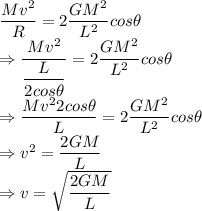
Physics, 26.12.2019 19:31 sajasolo3467
Three identical stars of mass m form an equilateral triangle that rotates around the triangle’s center as the stars move in a common circle about that center. the triangle has an edge length of l. what is the speed of the stars?

Answers: 2


Another question on Physics

Physics, 21.06.2019 17:20
The momentum of an isolated system is conserved a) only in inelastic collisions. b) only in elastic collisions. c) in both elastic and inelastic collisions
Answers: 2

Physics, 22.06.2019 03:00
An internally reversible refrigerator has a modified coefficient of performance accounting for realistic heat transfer processes of where qin is the refrigerator cooling rate, qout is the heat rejection rate, and is the power input. show that copm can be expressed in terms of the reservoir temperatures tc and th, the cold and hot thermal resistances rt,c and rt,h, and qin, as where rtot rt,c rt,h. also, show that the power input may be expressed as 1.39 a household refrigerator operates with cold- and hot-temperature reservoirs of tc 5 c and th 25 c, respectively. when new, the cold and hot side resistances are rc,n 0.05 k/w and rh,n 0.04 k/w, respectively. over time, dust accumulates on the refrigerator’s condenser coil, which is located behind the refrigerator, increasing the hot side resistance to rh,d 0.1 k/w. it is desired to have a refrigerator cooling rate of qin 750 w. using the results of problem 1.38, determine the modified coefficient of performance and the required power input w under (a) clean and (b) dusty coil conditions. internally reversible refrigerator qout qin w high-temperature reservoir low-temperature reservoir th th,i tc,i tc high-temperature side resistance low-temperature side resistance w qin th tc qinrtot tc qinrtot copm tc qinrtot th tc
Answers: 2

Physics, 22.06.2019 06:00
When you push downward on a book at rest on a table, you feel an upward force. does this force depend on friction? defend your answer.
Answers: 2

Physics, 22.06.2019 21:10
An athlete swings a ball, connected to the end of a chain, in a horizontal circle. the athlete is able to rotate the ball at the rate of 8.13 rev/s when the length of the chain is 0.600 m. when he increases the length to 0.900 m, he is able to rotate the ball only 6.04 rev/s. (a) which rate of rotation gives the greater speed for the ball? 6.04 rev/s 8.13 rev/s (b) what is the centripetal acceleration of the ball at 8.13 rev/s? m/s2 (c) what is the centripetal acceleration at 6.04 rev/s? m/s2
Answers: 2
You know the right answer?
Three identical stars of mass m form an equilateral triangle that rotates around the triangle’s cent...
Questions



Biology, 16.10.2019 21:40

Biology, 16.10.2019 21:40

Computers and Technology, 16.10.2019 21:40




English, 16.10.2019 21:40


Computers and Technology, 16.10.2019 21:40


English, 16.10.2019 21:40


English, 16.10.2019 21:40



Social Studies, 16.10.2019 21:40

Mathematics, 16.10.2019 21:40


 = Angle
= Angle



